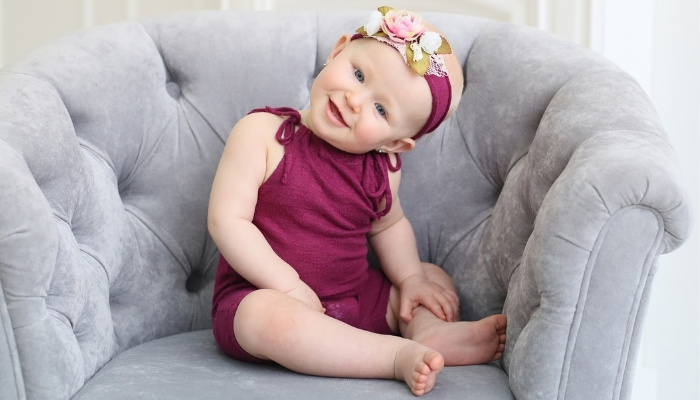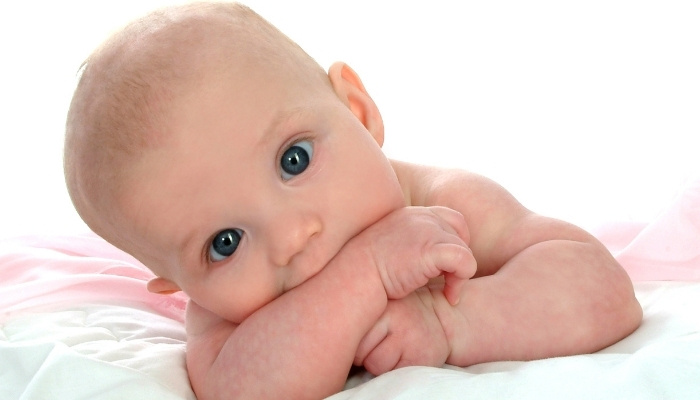It is common for babies to tilt their heads to one side when they are teething, as it helps to ease their discomfort. However, some babies may also do this when they are attempting to appear endearing, being tickled, or concentrating closely on something/someone.
Head tilting could possibly indicate an ear infection, a problem with the neck muscles or vision, or a neurological issue, so consult your pediatrician.
Common symptoms of teething include:
- Increased drooling
- Fussiness
- Gnawing and biting on objects
- Tugging on ears
- Tilting their head to one side
- Rubbing their cheeks
- A swollen bump under the gum
- Loose stools
- Changes in eating and sleeping habits
Milestone Clinic recommends having your baby checked by a physician for torticollis if your baby clearly prefers to look in one direction, has a continuous head tilt, or is becoming delayed in motor skills.
When I noticed one of my babies occasionally tilting his head to one side, I soon observed him tugging on his ear as well.
Not surprisingly, his doctor diagnosed him with an ear infection, and after treatment, all symptoms vanished.
Table of Contents
When To Be Concerned
You should be concerned about head tilting if your baby displays any signs of pain or their head seems to have a limited range of motion.
You should also be concerned if your baby has a temperature greater than 100.4 ℉. A fever could be a sign of an ear infection.
Why Baby Tilts Head to One Side When Teething
You should check for other symptoms if you notice your baby tilting their head to one side when teething.
The following presents explanations as to why your baby is tilting their head.
1. Attempt To Relieve Pain
If your baby suddenly leans and looks uncomfortable, he or she may be aching from teething.
You will know if your child is in pain if they’re also pulling on their ears.
Pain from gum inflammation can radiate into the ear canal, and babies may feel an aching in their ears.
Tugging on their ear can relieve some of this pain.
2. Ear Infection May Be To Blame
Besides normal teething pain, your child may also have an ear infection.
Ear infections are common in babies and young children due to the immature anatomy of the eustachian tube that connects the ear to the back of the throat.
The immature anatomy allows fluid to settle in the middle ear, and sometimes bacteria can build up.
This is particularly true for babies who lie down with a bottle or are exposed to secondhand smoke.
3. Trying To Be Cute or Funny
If your baby smiles while tilting their head to the side, they’re probably just trying to be cute or funny.
Some babies like to tilt their heads to the side because of the reaction they get from their caregivers.
Babies enjoy connecting with their loved ones. They might feel a sense of belonging if they strike a pose that makes their friends and family laugh or clap.
4. Concentrating on Something
Tilting the head sometimes helps babies concentrate on words spoken to them or objects in front of them.
Some babies tilt their heads when they’re unfamiliar with the person speaking to them.
5. Something Is Tickling Their Ear or Neck
Your baby’s head tilting could be an attempt to stop a tickling sensation they feel in their ear or on their neck.
Check for a stray hair, ear wax, threads from clothing, etc. The material from their bib could be irritating their skin as well.
6. Torticollis in Babies
Torticollis is a sign of improper development of the neck muscles that causes the head to twist and tilt to one side.
Torticollis Causes in Babies
- Congenital Muscular Torticollis: This can occur due to abnormal positioning in the womb or uneven development of neck muscles, resulting in shorter fibers on one side.
- Acquired Torticollis: This may develop after birth and can be caused by factors like trauma during delivery, swelling from reflux or infection, or improper sleeping positions.
Torticollis Baby Symptoms
- A flat spot behind the ear on one side
- Head rotates or tilts to one side
- A soft lump in the baby’s neck
- Limited range of motion in neck and head
- Hip dysplasia and other musculoskeletal problems
- Flattening of one side of the head
- Preferring one breast over the other during breastfeeding
Treatment
If you suspect your baby may have torticollis, consult your child’s primary care provider who can determine a diagnosis and connect you with appropriate treatment.
Typically, a referral to physical therapy will be given, and the therapist can teach you gentle stretching exercises to do at home. These exercises won’t harm your child.
You should also encourage your baby to take part in tummy time regularly to strengthen shoulder and neck muscles.
7. Neurological Issue
In cases where the head tilting seems to be involuntary or spasmodic, the baby should be evaluated for a neurological issue, according to this doctor.
8. Ocular Torticollis
Ocular torticollis is an abnormal head posture that helps babies see better in both eyes.
Besides tilting their head, your baby may also turn their face or raise their chin.

Baby Ear Infection vs. Teething
Since your baby isn’t talking yet, it may be challenging to determine what’s hurting them. It could be their ears, or it could be their emerging teeth.
Ear pulling, fussiness, and trouble sleeping are all symptoms of both ear infections and teething.
It can be difficult to determine what might be troubling your baby.
Managing symptoms in a fussy but otherwise well baby is perfectly fine, but for fever, poor fluid intake, or persistent fussiness, the best way to determine what is bothering your infant is to take them to their pediatric provider for a full assessment.
Baby Teething Signs
Every baby’s symptoms are different, but you can expect to see some of the following signs of teething in your child:
- Changes in sleeping or eating patterns
- Tender, swollen gums
- Touching their mouths with their hands
- Crying and fussiness
- Pulling their ears
- Rubbing their cheeks
- A low-grade fever (less than 101℉)
- Coughing
- Chewing on hard things
- Excess drool
- Drool rashes on skin
- Loose or more frequent stools (from swallowing excess drool)
When Babies Begin Teething
Babies typically start teething around 6 months of age, but this can vary widely.
Some babies may start teething as early as 3 months, while others might not begin until after their first birthday.
The timing of teething can be influenced by genetics, so if parents started teething early or late, their child may follow a similar pattern.
Here’s a general timeline of baby teeth emergence:
Central Incisors
- Lower: Around 6-10 months
- Upper: Around 8-12 months
Lateral Incisors
- Lower: Around 9-13 months
- Upper: Around 10-16 months
First Molars
- Lower: Around 13-19 months
- Upper: Around 14-18 months
Canines (Cuspids)
- Lower: Around 16-22 months
- Upper: Around 17-23 months
Second Molars
- Lower: Around 23-31 months
- Upper: Around 25-33 months
By the age of 3, most children will have their full set of 20 primary teeth.
Teething Baby Remedies
Try some of these methods to help your baby get through the painful stages of teething.
- Massage your baby’s gums with a clean finger.
- Use cold teethers, pacifiers, washcloths, or spoons. Clean after each use.
- You can give your baby cool water if older than 6-9 months.
Avoid the following types of teething treatment:
- Frozen solid teethers
- Teethers filled with liquid
- Teethers made of breakable material
- Teething necklaces
- Oral teething gels
Baby Ear Infection Signs and Symptoms
An ear infection typically comes with these unpleasant symptoms and signs in infants:
- Bloody, white, yellow, or green ear drainage
- Fever
- Irritability and crying, especially while lying down
- Trouble sleeping for a few nights
- Pulling at the ear
- Resistance to eating during mealtimes
Baby Ear Infection Treatment
If your baby develops an ear infection, your first step should be to call the pediatrician.
Whether it’s a mild ear infection or one that produces a high-grade fever, your child’s pediatrician should know how to treat it properly.
Some common treatments include:
- Antibiotics: The pediatrician may prescribe antibiotics. Give the medication as prescribed for as long as the doctor says is necessary.
- Other medications: If your child is fussy or uncomfortable, the pediatrician may recommend Tylenol or Motrin to treat discomfort. Fever alone is not harmful and does not have to be treated.
- Time: Fluid buildup without infection will likely clear up on its own. However, untreated or chronic ear infections can lead to damage to the eardrum over time. Always consult your child’s pediatric provider if you are concerned.
Prevention
Follow these steps to help reduce your child’s risk of ear infections:
- Avoid smoking in the house or around your baby.
- Always hold your baby at a 30 to 45-degree angle during feedings to help prevent fluid from backing up into the ears.
- Make sure your child gets all recommended vaccines on time (two of the most common ear infection bacteria are now part of the standard vaccine schedule).
Mom of three (including identical twin boys), wife, and owner of Parents Wonder. This is my place to share my journey as a mother and the helpful insights I learn along the way.

